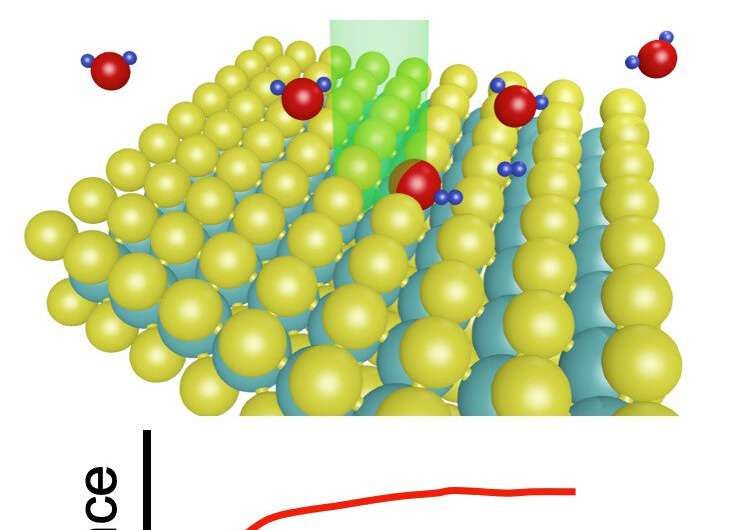Team develops laser processing method to increase efficiency of optoelectronic devices

Scientists at the U.S. Naval Research Laboratory (NRL) discovered a new method to passivate defects in next generation optical materials to improve optical quality and enable the miniaturization of light emitting diodes and other optical elements.
"From a chemistry standpoint, we have discovered a new photocatalytic reaction using laser light and water molecules, which is new and exciting," said Saujan Sivaram, Ph.D., lead author of the study. "From a general perspective, this work enables the integration of high quality, optically active, atomically thin material in a variety of applications, such as electronics, electro-catalysts, memory, and quantum computing applications."
The NRL scientists developed a versatile laser processing technique to significantly improve the optical properties of monolayer molybdenum disulphide (MoS2)—a direct gap semiconductor—with high spatial resolution. Their process produces a 100-fold increase in the material's optical emission efficiency in the areas "written" with the laser beam.
According to Sivaram, atomically thin layers of transition metal dichalcogenides (TMDs), such as MoS2, are promising components for flexible devices, solar cells, and optoelectronic sensors due to their high optical absorption and direct band gap.
"These semiconducting materials are particularly advantageous in applications where weight and flexibility are a premium," he said. "Unfortunately, their optical properties are often highly variable and non-uniform making it critical to improve and control the optical properties of these TMD materials to realize reliable high efficiency devices."
"Defects are often detrimental to the ability of these monolayer semiconductors to emit light," Sivaram said. "These defects act as non-radiative trap states, producing heat instead of light, therefore, removing or passivating these defects is an important step towards high efficiency optoelectronic devices."
In a traditional LED, approximately 90 percent of the device is a heat sink to improve cooling. Reduced defects enable smaller devices to consume less power, which results in a longer operational lifetime for distributed sensors and low-power electronics.
The researchers demonstrated that water molecules passivate the MoS2 only when exposed to laser light with an energy above the band gap of the TMD. The result is an increase in photoluminescence with no spectral shift.
Treated regions maintain a strong light emission compared to the untreated regions that exhibit much a weaker emission. This suggest that the laser light drives a chemical reaction between the ambient gas molecules and the MoS2.
"This is a remarkable achievement," said Berend Jonker, Ph.D., senior scientist and principal investigator. "The results of this study pave the way for the use of TMD materials critical to the success of optoelectronic devices and relevant to the Department of Defense mission."
More information: Saujan V. Sivaram et al, Spatially Selective Enhancement of Photoluminescence in MoS2 by Exciton-Mediated Adsorption and Defect Passivation, ACS Applied Materials & Interfaces (2019). DOI: 10.1021/acsami.9b00390
Journal information: ACS Applied Materials and Interfaces
Provided by Naval Research Laboratory




















